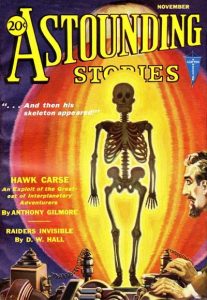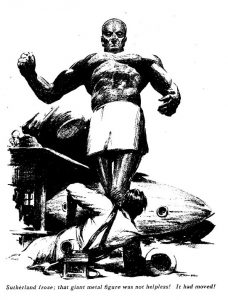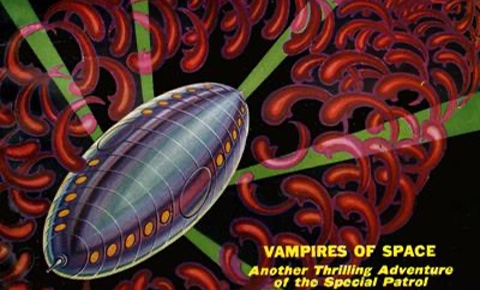 Hiram Gilmore Bates, III — better known as Harry Bates — was born in Pittsburgh, Pennsylvania on October 9, 1900. Best known as the original editor of ASTOUNDING STORIES magazine, he was also the author of “Farewell to the Master,” the story that inspired the classic science fiction film, THE DAY THE EARTH STOOD STILL.
Hiram Gilmore Bates, III — better known as Harry Bates — was born in Pittsburgh, Pennsylvania on October 9, 1900. Best known as the original editor of ASTOUNDING STORIES magazine, he was also the author of “Farewell to the Master,” the story that inspired the classic science fiction film, THE DAY THE EARTH STOOD STILL.
Bates worked for Clayton Publications in the 1920s as the editor of adventure pulp magazines. At the end of the decade, he convinced publisher William Clayton to add a science fiction title to his catalog. At that time, only AMAZING STORIES was publishing science fiction. Bates was not a fan of the young genre, calling the stories in AMAZING, “awful stuff,” “packed with puerilities,” and “written by unimaginables!”
Still, he had to make a go of Clayton’s new pulp and came up with a preliminary list of names. Bates felt ASTOUNDING “was gutsy and would compel attention.” More importantly, it was similar enough to AMAZING STORIES to attract the notice of readers. Additionally, he felt that the words, “of Super-Science” offered both science and “that great promiser of extras: Super. As a phrase, the flavor was a trifle vulgar, but the meaning was right on the beam.” He believed that the new Clayton title was sure to lure AMAZING’s fans.
Generating a punchy title was only the first challenge he faced with the fledgling magazine. Finding writers for the new genre was not easy. Bates talks about trying to convince professional writers from other genres to enter the science fiction field. “My biggest difficulty, and a never-ending one, was the obtaining of suitable stories. Clayton and I agreed that story elements of action and adventure were necessary for ASTOUNDING’s survival. . . We could think of fewer than half a dozen fair-to-good pulp writers who had ever written stories of the kind we wanted, but we never doubted that some of my adventure writers could produce them.” Clayton and Bates further determined that their stories would have both physical action and scientific explanation and would be less gadget-oriented than the stories in AMAZING.
Bates nursed his fledgling stable of science fiction writers very carefully. There were a lot of letters back and forth, a great deal of editing, re-writing, and patching. More than one writer quit, alienated over a story rejection. It’s difficult for us to imagine the perspective of those primogenital pulp writers and editors. It is even harder to visualize the almost blank page that Bates was presented with when he started ASTOUNDING STORIES in 1930. One advantage he had was that Clayton paid better than his competitors — two cents a word upon acceptance instead of half a cent a word. This allowed ASTOUNDING to draw better writers as the pulp title developed.
Bates did his share of writing for the magazine as well, filling out issues as needed. This is how the popular “Hawk Carse” series came into being. The series was published in ASTOUNDING — beginning in the November 1931 number — under the pen name of Anthony Gilmore. The Gilmore pseudonym (as well as another pen name, H. G. Winter) represented the work of Bates and his assistant editor, Desmond Winter Hall.
During his tenure with Clayton Magazines, Bates edited another new pulp, STRANGE TALES, a direct rival to WEIRD TALES. That magazine lasted for seven issues between 1931 and 1932.
In total, Bates edited thirty-four issues of ASTOUNDING STORIES from 1930 until 1933, after which time the Clayton group went bankrupt and ASTOUNDING was sold to Street & Smith. Bates’ editorial contributions to the science fiction field ended once F. Orlin Tremaine took over as editor of ASTOUNDING. But he was not done with science fiction entirely and continued to write and publish stories. He’s probably best known for the novelette, “Farewell to the Master” (ASTOUNDING SCIENCE-FICTION, October 1940). It was later adapted by Robert Wise as THE DAY THE EARTH STOOD STILL and released by 20th Century Fox in 1951.
 Bates’ original story has some key differences from the movie. First, it’s not a message piece: there’s no warning about mankind developing into a potentially dangerous race. The main interplay of characters is also dissimilar and largely takes place between a reporter, Cliff Sutherland, and the robot, Gnut (Gort in the movie). Klaatu is a very peripheral character, being dead for much of the story. Before the tale begins, Gnut is left inert in a museum after Klaatu is killed by a sniper. But the massive robot isn’t inactive, as Cliff finds out during an assignment. In the end, readers discover the robot’s secret and why he is so intent on revivifying Klaatu.
Bates’ original story has some key differences from the movie. First, it’s not a message piece: there’s no warning about mankind developing into a potentially dangerous race. The main interplay of characters is also dissimilar and largely takes place between a reporter, Cliff Sutherland, and the robot, Gnut (Gort in the movie). Klaatu is a very peripheral character, being dead for much of the story. Before the tale begins, Gnut is left inert in a museum after Klaatu is killed by a sniper. But the massive robot isn’t inactive, as Cliff finds out during an assignment. In the end, readers discover the robot’s secret and why he is so intent on revivifying Klaatu.
Bates published a few more science fiction stories during the 1940s and ’50s, the most notable being “The Death of a Sensitive” (SCIENCE-FICTION PLUS May 1953). The magazine’s editor, Sam Moskowitz, ranked Bates’ tale as the best story ever published in the Gernsback magazine.
Harry Bates played a very important role in the history of science fiction, although many contemporary fans may have never heard of him.
When people think of ASTOUNDING STORIES, they naturally connect it to its longtime editor, John W. Campbell. When they hear the phrase, “Klaatu barada nikto,” they only think of the movie from which it came, not the story on which it was based. Science fiction fans today are legion and sci-fi writers a dime a dozen. But a very long time ago, when science fiction was new, Harry Bates laid a foundation for the robust legacy that followed. He died in 1981, at the age of 80.
(Hannes Wessolowski would serve as the cover artist for all of the Bates issues of ASTOUNDING, including the November 1931 number. The first of Bates’ Hawk Carse stories — written in collaboration with Desmond W. Hall — was featured in the issue. Wesso — as he signed his work — also created the cover art for all seven issues of STRANGE TALES OF MYSTERY AND TERROR, the short-lived supernatural companion to ASTOUNDING.
After Clayton’s bankruptcy, Harry Bates occasionally returned to the science fiction genre in his writing. One instance was the novella “Farewell to the Master,” sold to John W. Campbell and published in the October 1940 ASTOUNDING SCIENCE-FICTION. Bates’ story was illustrated by Frank Kramer, a freelance pen and ink artist who primarily worked for Street & Smith.
Sara Light-Waller is a writer, illustrator, and avid pulp fan. Science fiction pulps are her favorites, especially space opera and thought variant stories. The Grand Prize winner of the 2020 Cosmos Prize — offered by First Fandom Experience for the best ending to the seventeen-part round-robin story that began in June 1933 — Sara has also published two illustrated New Pulp books with more to come. Catch up with her at Lucina Press where you can learn about her work and so much more.)






